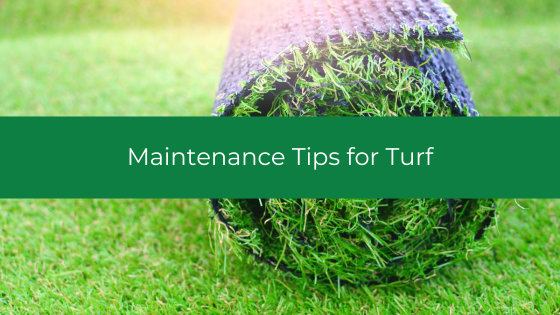Artificial grass requires minimal upkeep compared to natural grass, but to ensure your new synthetic grass lasts as long as possible, the following maintenance tips for turf are recommended:
- Clear debris and pet waste from the turf promptly
- Rinse the turf to wash away dirt and pollen
- “Bloom” the turf with a broom or rotary brush
- Remove weeds if they emerge
- Apply mold and fungal barrier as needed
- Invest in quality site preparation
- Know when it’s time to call the turf experts
The above maintenance tips will preserve your turf for as long as possible and ensure it looks (and feels) its best year-round.
A Checklist of Maintenance Tips for Turf
One of the standout advantages of synthetic grass is its low-maintenance design. Unlike natural grass, turf requires zero mowing and landscaping, and nearly zero watering. As a result, you’ll spend much less time (and money) keeping your artificial grass in good shape. The following maintenance tips for turf are recommended to guarantee optimal value and longevity:
Clearing debris and pet waste from the turf promptly – If heavy objects or piles of pet waste are allowed to sit on the synthetic grass for long, it will press down on the turf and flatten the grass blades. This can be corrected, but it’s easier to prevent by promptly removing anything from the turf that doesn’t belong there.
Liquid or solid pet waste can eventually stain and potentially damage the turf, so cleaning it off the artificial grass is important if you have pets if the turf is exposed to heavy pet traffic.
Rinsing the turf to clear dirt, pollen and waste – The only water you’ll need for your synthetic grass is what’s required to occasionally rinse it. Rinsing the artificial grass is an effective way to keep dirt, dust and pollen at bay, which is important if your family members are prone to allergies.
Rinsing will also wash away any liquid pet waste, which will help prevent urine odors from affecting your dog runs or pet areas.
Blooming the turf with a broom or brush – After long-term exposure to heavy traffic, wear and weather, the turf’s blades may be pressed flat and matted to the artificial grass surface. To stand it back up and restore its appearance, it’s recommended that synthetic grass owners “bloom” their turf by running a broom across the turf’s surface, in the opposite direction the blades are lying in. This will push the turf’s blades up. If a broom isn’t time or effort-efficient enough, a rotary brush will do the job in a fraction of the time. Of course, not everyone owns a rotary brush, so many property owners choose to partner with a professional turf company for their turf maintenance.
Removing weeds when they emerge – If your artificial grass is professionally installed, it will come with a weed barrier that prevents weeds from growing through the synthetic turf. This, along with detailed site preparation, will extend the time it takes for any vegetation to grow back.
When weeds do appear, an important maintenance tip for turf is to remove the weeds down to the root. This will prevent the weeds from fraying the turf’s edges or pulling it apart at the seams.
Applying fungal and mold prevention as needed – In Houston and The Woodlands, or in any humid area, mold and fungal growth are a threat to anything constantly exposed to the climate. This includes artificial turf.
While synthetic grass is less likely to harbor mold than natural grass, it is still a potential risk. To mitigate this risk, there are non-toxic, pet and child-safe mold removers on the market designed specifically for artificial turf. Turf companies keep them on hand and can provide them to turf owners when needed.
Investing in quality site preparation – Site prep includes all of the initial work necessary to ensure a level, well-draining installation site for your artificial grass.
Thorough site preparation includes land clearing, topsoil removal, soil stabilization and grading. It’s a process that requires expertise and resources, which means you will need a reputable, established turf installer to ensure effective site prep.
Knowing when it’s time to call the professionals – Most artificial grass maintenance can be performed by property owners, but occasionally something comes up that requires an expert turf maintenance company. For example, anything sticky (like tree sap) will need an expert to remove. Tears and failing turf seams also merit professional attention. By partnering with a professional turf crew for your artificial grass maintenance, you’ll have expert-quality repairs and upkeep when you need them.
These Maintenance Tips Will Keep Your Turf in Tip Top Shape
Artificial turf is valued for its low maintenance design, with no mowing or watering required. However, a bit of occasional maintenance will ensure your turf lasts longer and always looks its best. Artificial grass owners can handle most of this maintenance on their own, but professional turf installers can also provide turf maintenance and repairs as needed, or just to save you time and effort.
- Choosing The Best Pet Turf - April 16, 2025
- The Benefits of Having Artificial Turf in Houston - April 2, 2025
- Best Types of Artificial Turf for Residential Lawns - February 28, 2025


